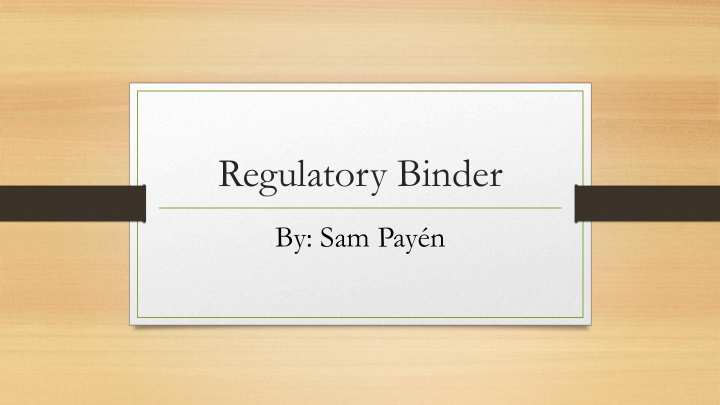



Regulatory Binder By: Sam Payén
Regulatory Binder Goals • To learn about regulatory binders. • To learn about Essential documents for the regulatory binder • Put together a regulatory binder
Purpose The purpose of the Regulatory Binder is to provide an organizational framework for filing paper versions of essential study documents (or referencing location of an electronically stored file). Who Creates and Maintains Study coordinators or individuals responsible for establishing the Essential Document Binder ( synonyms: Investigator Binder , Regulatory Binder, Investigational Site File (ISF), or Study Binder). It is the responsibility of the Investigator to ensure compliance with Good Clinical Practice (GCP), institutional review board (IRB), and applicable regulatory requirements.
Instructions Create tabs for each section listed below and place the appropriate documents in each corresponding section in a binder. Be sure to label the outside of the binder (cover and spine) with the protocol number, PI name, and study site. Use multiple binders or master binders to maintain documentation if needed. Store items in reverse chronological order, with the newest items within a section placed at the front of the section. Multi-site studies: the lead site may choose to customize the checklist for the study and provide to all participating sites. Anytime information is kept in a master binder, place a note to file (in the section of the Binder) referencing the location of the separate binder.
Things to Know about Essential Documents According to GCP guidelines Essential Documents are those documents which individually and collectively permit evaluation of the conduct of a trial and the quality of data produced. These documents serve to demonstrate compliance with standards of Good Clinical Practice and with all applicable regulatory requirements. Filing essential documents in a timely manner can greatly assist in the successful management of a clinical trial or research study. The Regulatory Binder is often the first document reviewed during audits and inspections. Not all the essential documents are available at the start of the study and may never be depending on the type of study you are conducting. Documents can be grouped into those that are generated before study initiation, those that are generated during trial conduct and those that are generated after study completion. Not all documents have to be filed in one single binder. The Regulatory Binder may sometimes consist of several binders that are stored in the same or different locations. It is important to know where all these documents are located to be able to pull them out when needed in a timely manner.
Study Team Study Team Contact List Study Team Signature and Delegation Log CVs, Licenses, Financial Disclosures, Applicable Certifications of Key Study Personnel Training log Protocol Study Protocol & Amendments IRB Stamped Consent Document and Translations IRB Stamped Advertisements Investigator Brochure (IB) Safety Update letter for inclusion in IB Sample of Questionnaires / Survey forms Sample of Diary cards Sample of Memory aids for study procedures Any other written information given to the patient Sample of CRF
Regulatory Committee for Protection of Human Subjects (IRB) IRB Submission F orms (Initial, amendments, renewals, etc.…) IRB Outcome L etters (approvals, acknowledgments, etc.…) IRB Correspondence (or location) Food and Drug Administration Form FDA 1572 for all Key Study Personnel Copy of IND / IDE submission FDA Correspondence Annual Reports
Patient Logs Screening Log Enrollment Log Subject Visit Schedule Log Signed Informed Consent Forms (or Location) Unanticipated Problems Copies of AE reports if not included in CRF AE log for events in non-site subjects AE log for events in site subjects Adverse Event Reports Protocol Deviation logs
Drug / Device Accountability Package Insert / Prescribing Information Drug / Device Receipt (Shipping Records) Drug / Device Accountability Log Drug Disposal Records Sealed Unbinding envelopes (or location) Individual treatment codes (or location) Temperature logs
Laboratory Laboratory name and contact address Logistic arrangements with lab (if local lab is used) Lab certifications and normal ranges Biological specimen sampling, labeling, storing and shipping procedure Biological specimen log Shipping records (if central lab is used) Temperature logs Monitoring Monitoring Log Monitoring reports Initiation meeting information (sign in sheet, agenda, minutes etc…) Correspondence
Financial Documents Clinical Trial Agreement Budget Financial expenditure records Billing statements (all these documents may be stored in a separate location) Other documents Completed CRF’s (location) Study closure documentation Publications, presentations, manuscripts, etc…
This and any other information can be found in our UT Health CPHS web site which I have included in this slide: https://www.uth.edu/cphs/ https://www.uth.edu/ctrc/regulatory/gcp-policies.htm https://www.uth.edu/cphs/for-researchers/reg-iris-training.htm https://www.uth.edu/cphs/for-researchers/training.htm
Questions or Comments
Thank You! Gracias!
Recommend
More recommend